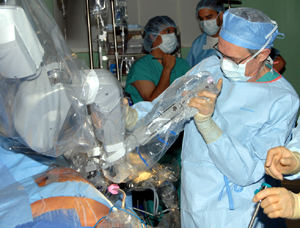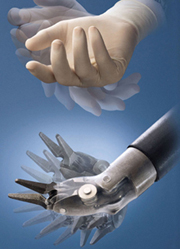

 |  |
PERFORMING MINIMALLY INVASIVE ROBOTICALLY-ASSISTED CORONARY BYPASS SURGERY
More than half a million coronary bypass operations are performed each year in the United States to fix clogged arteries and improve blood flow to the heart. At Stony Brook University Medical Center — home of the only heart surgery program in Suffolk County — we have provided the best possible surgical care for many thousands of patients needing a coronary bypass, since 1980, when our cardiothoracic surgery service was established.

![]() Traditional "open heart" coronary bypass surgery involves stopping the heart to perform the procedure and using cardiopulmonary bypass (CPB); that is, routing the blood through the heart-lung machine to maintain the patient while the heart is stopped. It also requires a large incision and splitting the sternum (breastbone), resulting in a large scar and a lengthy recovery time.
Traditional "open heart" coronary bypass surgery involves stopping the heart to perform the procedure and using cardiopulmonary bypass (CPB); that is, routing the blood through the heart-lung machine to maintain the patient while the heart is stopped. It also requires a large incision and splitting the sternum (breastbone), resulting in a large scar and a lengthy recovery time.
The mid-1990s saw the advent of the minimally invasive approach to coronary revascularization called "beating heart" surgery, also known as "off pump" surgery. This new approach avoids the use of the heart-lung machine. Consequently, patients do not experience the inflammatory response caused by CPB, which disrupts the body's physiologic balance.
The minimally invasive direct coronary artery bypass (MIDCAB) beating heart procedure was developed at that time, in addition to other off pump procedures.
Patients needing bypass procedures involving one or two vessel grafts could undergo MIDCAB instead of traditional bypass surgery. Using smaller incisions and not requiring the sternum to be split open, MIDCAB produces less trauma, less pain, and faster recovery.
Now, as a leader in minimally invasive heart surgery, our cardiothoracic surgery service performs robotically-assisted MIDCAB, which constitutes an improvement over the original MIDCAB that requires a five-inch incision and spreading the ribs for access to the heart.
The new robotically-assisted procedure allows the surgeon to optimize the preparation of the internal mammary arteries, the best vessels for bypass grafts, which produce the most reliable, most protective, and longest-lasting treatment of coronary artery obstruction. Twenty- and 25-year bypass patency is not uncommon.
|
l Avoidance of heart-lung machine l Best possible quality of bypass grafts l Smaller incisions l Less pain and scarring l Less risk of infection |
l Less anesthesia l Less blood loss and fewer transfusions l Shorter hospital stay l Faster recovery l Quicker return to normal activities |
This historic advance in heart surgery at Stony Brook is the result of our acquisition in 2007 of the da Vinci surgical robot. In fact, our medical center became the first medical center on Long Island to acquire the most technically advanced model of the robot, the da Vinci S.
Our new robot is a highly sophisticated tool that enables surgeons to perform a variety of complex operations, such as coronary bypass surgery. The robotic system makes it possible for them to perform surgery without large incisions by way of superior visualization, enhanced dexterity, and greater precision, which ultimately raises the quality of surgical care.
Dr. Frank C. Seifert, director of minimally invasive bypass surgery, is leading our use of the da Vinci robot to perform MIDCAB surgery. He has been specially trained and certified to operate with the robot.
A nationally recognized expert in MIDCAB and other off pump techniques that avoid the heart-lung machine, Dr. Seifert has performed nearly 400 MIDCAB operations at Stony Brook (as of May '08), in addition to nearly 2,000 other kinds of beating heart bypass operations. He is one of the few surgeons in the country who mastered the technical challenges of the MIDCAB procedure that have limited its use in the hands of other surgeons.
Commenting on the significance of the da Vinci surgical robot, Dr. Seifert says: "The new robot represents a major advance in coronary bypass surgery that offers patients more benefits of the minimally invasive approach. My operating vision is two to three times greater with it, and there is no loss of depth perception. As visual clues replace touch, the dexterity of the robot's hands is certainly greater than that of the human hand, and should contribute to improved outcomes."
"Ultimately, with anticipated further advances," emphasizes Dr. Seifert, "robotically-assisted surgery represents the future of all coronary bypass surgery — single- or multi-vessel off pump surgery that doesn't require use of the heart-lung machine or the sternotomy incision. In fact, techniques using the robot are being developed to join the grafted vessels to the heart without use of direct suturing by hand, and then we will see true 'robotic' surgery."
USING THE ROBOT
First of all, the surgeon performs the operation using the robot — not the other way around. The da Vinci robotic system is high-tech equipment designed to expand the surgeon's capabilities and offer a minimally invasive option for major surgery, such as coronary bypass surgery.

![]() The surgeon sits in a console equipped with controls that direct the robot's arms to perform the surgery. The robotic arms are very agile, and work as an extension of the surgeon's hands.
The surgeon sits in a console equipped with controls that direct the robot's arms to perform the surgery. The robotic arms are very agile, and work as an extension of the surgeon's hands.
With da Vinci, small incisions are used to introduce miniaturized wristed instruments and a high-definition three-dimensional camera. The surgeon, thus, can view a magnified, high-resolution three-dimensional image of the surgical site. At the same time, state-of-the-art robotic and computer technologies scale, filter, and seamlessly translate the surgeon's hand movements into precise micro-movements of the da Vinci instruments.
The system cannot be programmed, nor can it make decisions on its own. Rather, the da Vinci robot requires that every surgical maneuver be performed with direct input from the surgeon. Indeed, the surgeon is controlling every aspect of the operation.
To perform robotically-assisted MIDCAB, three or four small (half-inch) incisions are first made between ribs — for inserting the robot's arms, the video camera, and the surgical instruments — to enable the surgeon to prepare the mammary artery graft(s). Then, a two-inch incision, also between ribs, is made for suturing the artery graft to the heart directly by hand.
The heart continues to beat during the surgery, and no heart-lung machine is required.
The superior viewing system and wristed instruments of da Vinci allow the surgeon to operate with greater precision, resulting in fewer complications and potentially better outcomes, compared with conventional MIDCAB — outcomes far better than those achieved with traditional "on pump" coronary bypass surgery.
Patients who undergo robotically-assisted MIDCAB can be discharged from the hospital as early as the second postoperative day.
